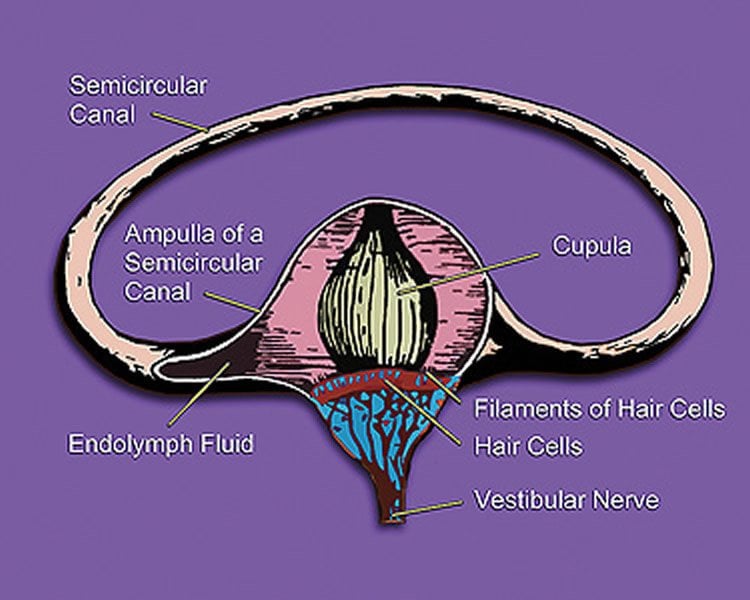Summary: Researchers have identified a new type of vertigo. The study reveals people with this new form of vertigo are more likely to have severe motion sickness than those with other types of the condition.
Source: AAN.
Neurologists have identified a new type of vertigo with no known cause, according to a study published in the May 23, 2018, online issue of Neurology.
With vertigo, people have episodes of dizziness that can last from minutes to days. Vertigo can be caused by serious conditions, such as tumors, or conditions that are fairly benign, such the inner ear disorder Meniere’s disease. But for some people, no cause can be found.
In this new study, neurologists have identified a new type of vertigo where treatment may be effective.
“These conditions can be difficult to diagnose and quite debilitating for people, so it’s exciting to be able to discover this new diagnosis of a condition that may respond to treatment,” said study author Ji-Soo Kim, MD, PhD, of Seoul National University in Seongnam, South Korea.
To diagnose this new condition, the person sits in a dark room and the examiner moves the patient’s head forward and then the head is shaken horizontally for about 15 seconds. Then the patient opens his or her eyes and a video recording is taken of eye movements. The neurologists discovered that after the test people with this new condition had eye movements called nystagmus that lasted longer than for other people. The new condition is called recurrent spontaneous vertigo with head-shaking nystagmus.
Among 338 people with vertigo with no known cause, 35 had this new condition and were included in the study. The participants had attacks of vertigo ranging from two or three times a week to once a year. They also experienced nausea or vomiting, headaches and intolerance of head motions during the attacks.
The participants were compared to 35 people with other conditions that can cause vertigo, such Meniere’s disease, vestibular migraine and vestibular neuritis. The test measured the time constant, or the time that represents the speed with which the reflexive eye movements can respond to change. For those with the new condition, the time constant during the primary phase of the nystagmus was 12 seconds, while it was six seconds for those with Meniere’s disease and five seconds for those with vestibular neuritis and vestibular migraine.

The neurologists also found that people with the new type of vertigo were more likely to have severe motion sickness than those with other types of vertigo.
A total of 20 of the 35 people with the new type of vertigo who had frequent attacks and severe symptoms were given preventive medication. About one-third of those had partial or complete recovery with the new medication. During the long-term follow-up of an average of 12 years after the first symptoms for 31 participants, five reported no more attacks, 14 said their symptoms had improved and only one said symptoms had gotten worse.
Kim said that people with this condition may have a hyperactive mechanism in their vestibular system that helps the brain respond to movement of the body and in the environment.
“It’s possible that the vertigo occurs when this unstable mechanism is disrupted by factors either within the person’s body or in their environment,” Kim said.
Funding: The study was supported by the National Research Foundation of Korea.
Source: AAN
Publisher: Organized by NeuroscienceNews.com.
Image Source: NeuroscienceNews.com image is in the public domain.
Original Research: Abstract for “Recurrent spontaneous vertigo with interictal headshaking nystagmus” by Sun-Uk Lee, Jeong-Yoon Choi, Hyo-Jung Kim and Ji-Soo Kim in Neurology. Published May 23 2018.
doi:10.1212/WNL.0000000000005689
[cbtabs][cbtab title=”MLA”]AAN “New Type of Vertigo Identified.” NeuroscienceNews. NeuroscienceNews, 25 May 2018.
<https://neurosciencenews.com/new-vertigo-9138/>.[/cbtab][cbtab title=”APA”]AAN (2018, May 25). New Type of Vertigo Identified. NeuroscienceNews. Retrieved May 25, 2018 from https://neurosciencenews.com/new-vertigo-9138/[/cbtab][cbtab title=”Chicago”]AAN “New Type of Vertigo Identified.” https://neurosciencenews.com/new-vertigo-9138/ (accessed May 25, 2018).[/cbtab][/cbtabs]
Abstract
Recurrent spontaneous vertigo with interictal headshaking nystagmus
Objective To define a disorder characterized by recurrent spontaneous vertigo (RSV) of unknown etiology and interictal headshaking nystagmus (HSN).
Methods We characterized HSN in 35 patients with RSV-HSN compared to that recorded in randomly selected patients with compensated vestibular neuritis (VN), vestibular migraine (VM), and Ménière disease (MD).
Results The estimated time constant (TC) of the primary phase of HSN was 12 seconds (95% confidence interval [CI] 12–13) in patients with RSV-HSN, which was larger than those in patients with VN (5 seconds, 95% CI 4–5), VM (5 seconds, 95% CI 5–6), or MD (6 seconds, 95% CI 5–6). TCs of the horizontal vestibulo-ocular reflex were also larger during the rotatory chair test in patients with RSV-HSN. Among the 35 patients with RSV-HSN, 7 showed vigorous long-lasting HSN with a peak slow-phase velocity >50.0°/s. In 5 patients (5 of 7, 71%) with vigorous HSN, HSN could have been induced even with headshaking for only 2 to 5 seconds. Long-term prognosis was favorable, with a resolution or improvement of the symptoms in more than half of the patients during the median follow-up of 12 (range 2–58) years from symptom onset. None developed VM, MD, or cerebellar dysfunction during the follow-up.
Conclusion The clinical features and characteristics of HSN in our patients indicate a hyperactive and asymmetric velocity-storage mechanism that gives rise to intermittent attacks of spontaneous vertigo probably when marginal compensation of underlying pathology is disrupted by endogenous or exogenous factors.







